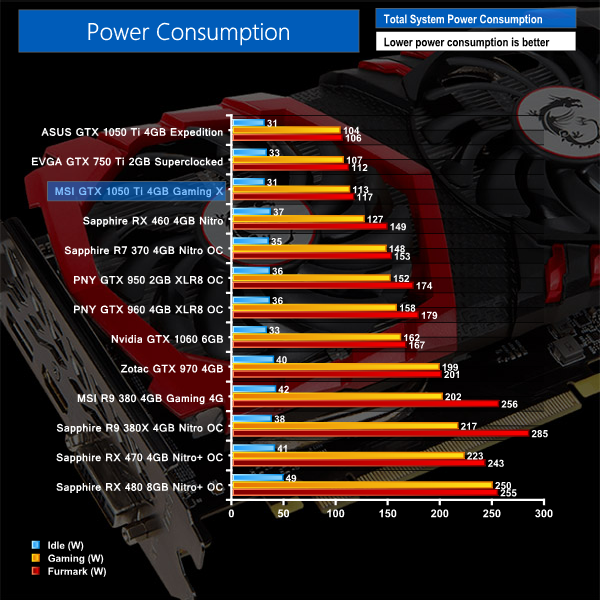We first measure power while the card is sat idling at the Windows 10 desktop for 5 minutes. Gaming power draw is recorded by running Unigine Heaven DX11 benchmark for 5 minutes. As a maximum stress test, Furmark is run for 5 minutes and the cards' power draw levels are recorded.
A separate system is used to test power draw in order to further put the onus on the energy being used by the graphics card. A relatively power-efficient Core i5-6400 CPU is paired with a single SSD and 750W Platinum-rated EVGA P2 PSU.
Power consumption is where the GTX 1050 Ti really starts to shine. Idling at the joint-lowest values seen by our test system, MSI's GTX 1050 Ti Gaming X graphics card barely breaks 100W of system-wide power draw under gaming load. The use of a 6-pin PCIe power connector allows MSI's card to draw an extra few Watts over ASUS' 75W board. This is the reason behind the MSI card's better gaming performance.
Looking at the AMD competition, RX 460 4GB requires 12% more power (for gaming) than MSI's card, yet turns in consistently lower frame rates. The performance premium for Sapphire's RX 470 4GB comes at the cost of almost double the power consumption. The very similar performance offered by GTX 960 dictates 40% higher power draw.
With that said, a 49W power draw increase does take you to GTX 1060 6GB performance. So the GTX 1050 Ti isn't necessarily the best power-vs-performance card on the market.
The power efficiency of Nvidia's Pascal architecture is simply superb.
Be sure to check out our sponsors store EKWB here
 KitGuru KitGuru.net – Tech News | Hardware News | Hardware Reviews | IOS | Mobile | Gaming | Graphics Cards
KitGuru KitGuru.net – Tech News | Hardware News | Hardware Reviews | IOS | Mobile | Gaming | Graphics Cards



